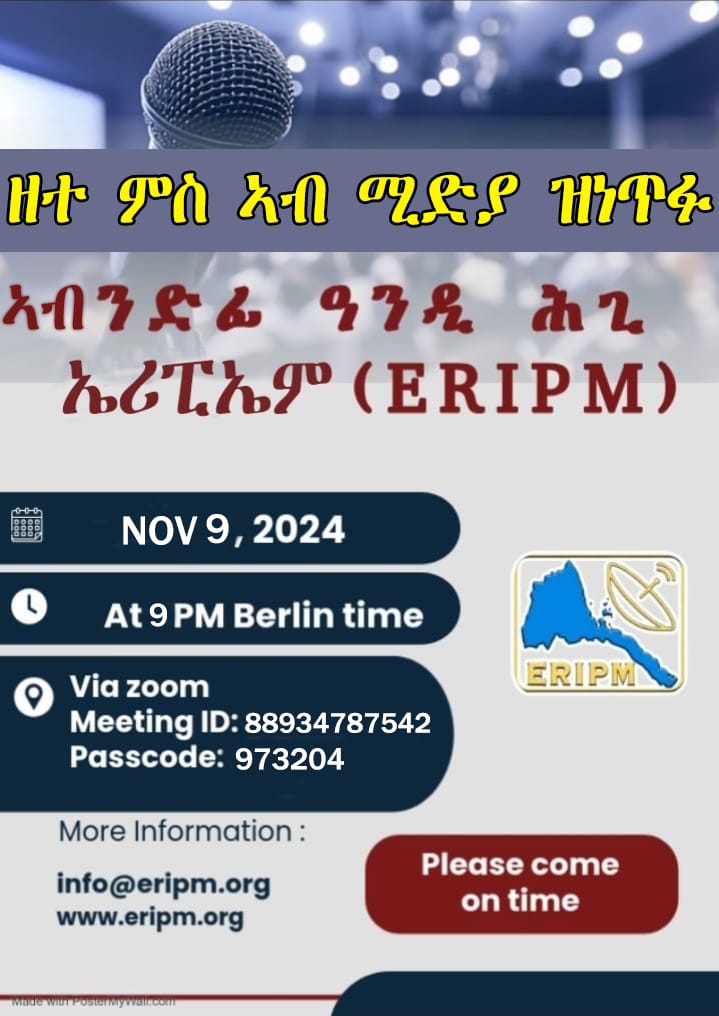
ERITREA PUBLIC MEDIA
DRAFT BYLAW
Table of Contents
ARTICLE 1: NAME AND LOCATION OF THE MEDIA ORGANIZATION.. 2
ARTICLE 2: VISION, PURPOSE, AND VALUE.. 2
ARTICLE 3: ORGANIZATIONAL STRUCTURE.. 4
ARTICLE 5: APPOINTMENTS AND REMOVALS OF OFFICERS. 7
ARTICLE 6: ROLES AND RESPONSIBILITIES ERIPM OFFICES. 8
ARTICLE 7: OFFICERS MANAGEMENT AND DUTY PROTOCOLS. 12
ARTICLE 8: ADMINISTRATION OF DONATIONS. 14
ARTICLE 9: PROHIBITED ACTIVITIES. 15
ARTICLE 10: OTHER FINANCIAL MATTERS. 16
ARTICLE 11: INTELLECTUAL PROPERTY RIGHT.. 18
ARTICLE 12: AMENDMENTS TO BYLAWS. 18
ARTICLE 1: NAME AND LOCATION OF THE MEDIA ORGANIZATION
SECTION 1: NAME OF THE ORGANIZATION
- The name of the organization, as a reflection of our vision and objectives, shall be the Eritrean Public Media henceforth acronymed as ‘ERIPM’.
- ERIPM is a non-profit, educational, and secular media corporation organized under the Nonstock Corporation Act of the State of Maryland (hereinafter “Corporation”).
- ERIPM is a public media.
SECTION 2: LOGO
Like our name, our logo is an integral part of who we are. It conveys the full collective power of our mission to our members, supporters, and the public at large.

SECTION 3: OFFICE OF THE CORPORATION
The principal office of this Corporation shall be situated in the State of Maryland at such specific location as the Board of Directors shall determine from time to time. The Corporation may also have such other offices as the Board of Directors determines from time to time.
ARTICLE 2: VISION, PURPOSE, AND VALUE
SECTION 1: VISION
Our vision is the realization of a prosperous Eritrea governed by a democratic system that enshrines equality and empowerment of its citizens as provided by a constitution to be formulated and agreed upon by the Eritrean People.
SECTION 2: MISSION
Our mission is to establish media outlets, both radio and television, that inform, educate, engage, and empower the Eritrean people.
SECTION 3: VALUE
Our values are openness, truthfulness, standing up for justice and freedom, disseminating accurate information, accountability and respect to diversity.
SECTION 4. PURPOSE
- General Purpose. The Corporation is organized and operated for the following general purposes:
- Exclusively for charitable and educational purposes within the meaning of §501(c)(3) of the Internal Revenue Code of 1986 (as amended) or the corresponding provision of any future United States internal revenue law, including for such purposes, the making of distributions to organizations which are recognized as exempt from tax under such §501(c)(3).
- To exercise such of the rights, powers, duties and authority of a non-profit corporation organized under the Maryland Nonstock Corporation Act of the State, which are consistent with the preceding paragraph.
- To raise awareness through civic education as may be relevant to human rights and good governance.
- To encourage dialogue among Eritrean media and other interest groups in advancing human rights, conflict resolution and promotion of tolerance, equality and diversity.
- Specific task
- To capture/document and share/disseminate information to Eritrean public.
- To conduct and facilitate interviews, dialogues, and panel discussions on the issues of human rights that would accelerates the urgency for democratic change in Eritrea.
- To mobilize Eritreans in the diaspora to stand for justice and democracy in Eritrea.
- To find talented Eritrean professionals and recruit them to join the media team.
- To solicit support from international entities who stand for justice and democracy.
ARTICLE 3: ORGANIZATIONAL STRUCTURE
Figure 1: Organizational structure of ERIPM

SECTION 1. ORGANIZATIONAL HIERARCHY
The ERIPM has seven important Organs:
- General Assembly
- Board of Directors
- Chief Executive Officer
- Departments and Support Staff
- Advisory Board
- Election and Grievance Committee
- Audit
SECTION 2: GENERAL ASSEMBLY
Supremacy of the General Assembly
The General Assembly is the supreme body of the ERIPM.
SECTION 3: POWERS AND RESPONSIBILITIES OF THE GENERAL ASSEMBLY:
- To amend & ratify the ERIPM Bylaws as may be
- To elect members of the Board of Directors.
- To hear and approve the Board of Directors’ annual
- To chart the general direction of the Corporation
ARTICLE 4: MEMBERSHIP
SECTION 1: GENERAL ASSEMBLY MEMBERSHIP
- Anyone who is Eritrean or of an Eritrean origin and is at least eighteen (18) years old is eligible to join the corporation worldwide as a member of the General Assembly.
- All ERIPM volunteers automatically become members of the general assembly and are not required to pay a membership fee.
Conditions of members
- Who has a legitimate interest in the objectives, core values, mission, and vision of the ERIPM
- Who consents to follow the guidelines set forth in the corporation’s bylaws.
- Vetted and approved by the ERIPM membership vetting committee, which is overseen by human resources department.
- Any membership request may be denied by ERIPM, with or without explanation.
SECTION 2: GENERAL ASSEMBLY RIGHT & RESPONSIBILITIES
SECTION 2.1: MEMBERSHIP RIGHTS
- Every member has a single, non-assignable right to vote in elections for the Board of Directors or any other body to which Board of Directors has delegates authority.
- To take part in discussions and be elected to serve on the Board of Directors or in any other appropriate office.
- Ratify, and revise the bylaws as needed
SECTION 2.2: MEMBERSHIP RESPONSIBILITIES
Shall be the duty and responsibility of each member of the ERIPM to:
- Work in the corporation’s best interests and to further its objectives and policies.
- Comply with the bylaws and protect the corporation from any threats.
- Participate in meetings, campaigns, and other activities as directed by the Board of Directors that promote the corporation.
- ERIPM monthly membership fee shall be $ 20
- Make monthly or yearly membership fees payments (will be defined, drafted, and agreed by Board of Directors) – a member who carries 3 months’ unpaid membership fees does NOT have the right to vote in any elections that the Election and Grievance Committee holds or in any other decision that the General Assembly makes.
- Members will be eligible to exercise their right to vote or any other rights stipulated in the bylaws after a six-month probationary period.
SECTION 5: TERMINATION OF MEMBERSHIP
- A member who violates any of the ERIPM rules or regulations will receive two written warnings from the Board of Directors’ Committee of Officers, which consists of the Chairperson, Secretary, and Treasurer.
- The Board of Directors’ Committee of Officers has the authority to terminate a member if violations continue after two written warnings. The decision of the Committee shall be reported at the next General assembly meeting.
- A person who has been terminated has ONE chance to appeal their case so that the entire Board of Directors can hear it. The board will have the last word in the issue.
- The general assembly may also expel members for grave errors without issuing a written warning by a two-thirds majority vote.
SECTION 6: MEMBERSHIP TIER
- The Board of Directors, in its sole discretion, shall create such membership types and
classifications that it deems appropriate. In creating a membership layer, the Board of
Directors shall adopt, by a two-thirds vote, a written resolution which identifies eligibility for the class along with voting rights, eligibility to serve in a board or other positions and any other details deemed appropriate at the time of adoption.
- Membership layers may be rescinded by a two-thirds vote of the Board of Directors
as well. All changes in membership class take effect on the first day of the upcoming
fiscal year.
- The tier of membership shall be as follows, having all members a single, non-assignable right to vote
- Silver tier $ 20 per month (Mandatory monthly membership fee)
- Gold Tier $ 50 per month
- Platinum tier $ 100 per month
- VIP tier $ 200 month
SECTION 7. GENEAL ASSEMBLY MEETINGS
- The General Assembly shall have once a year regular General Meeting held in the second half of the month of March.
- Extraordinary meetings could be called by demand of 2/3 of Board of Directors or members of the General Assembly
- Agendas, date, and location for the annual meeting shall be announced and members informed at least a month ahead of meeting date.
- The General Meeting shall have a quorum of simple majority of members of the General Assembly.
- If the quorum of simple majority is not met in the first attempt, the date of the next assembly is set and meeting shall be adjourned. The following scheduled meeting shall conduct business irrespective of meeting the quorum and its deliberations shall be legal.
SECTION 7. LEAVE OF ABSENCE
- If a board member resigns, the Board of Directors promptly replace it from the reserve list. In the absence of a reserve list, the board of directors shall call extraordinary meeting, and the General assembly appoints a replacement until the next general assembly meeting.
- If the Chief Executive officer resigns, the board of directors promptly replace with interim Chief executive officer until the next general assembly meeting or call an extra ordinary meeting of the General assembly for approval of the new appointee
ARTICLE 5: APPOINTMENTS AND REMOVALS OF OFFICERS
SECTION 1: BOARD OF DIRECTORS
The Board of Directors shall consist of not less than five nor more than nine members, the exact number of which shall initially be determined by the General Assembly and thereafter from time to time by the Board of Directors. In the event of an emergency, members of the general assembly will appoint three more directors to stay in the waiting list.
SECTION 2: CHIEF EXECUTIVE OFFICER APPOINTMENT
- The Board of Directors shall appoint the Chief Executive Officer (CEO) and approved by the General Assembly. The Chief Executive officer is accountable for the board of directors.
SECTION 3: DEPARTMENT HEADS APPOINTMENT
- The CEO appoints department heads through a competitive hiring process, with board approval, and they report to the CEO.
SECTION 4: REMOVAL OF THE CHIEF EXECUTIVE OFFICER AND DEPARTMENT HEADS
- The Board of Directors may dismiss The CEO after consulting with general assembly in accordance with the mutually agreed-upon disciplinary measures.
- The CEO may dismiss a department head after consulting with the board of directors in accordance with the mutually agreed-upon disciplinary standards.
SECTION 5: ELECTION AND GRIEVANCE COMMITTEE
- The General Assembly shall appoint an “Election and Grievance Committee” with five to seven members to help in the Board of Directors election process.
- Develop tools for selection criteria as election procedure.
- Compile a list of possible candidates for the Board of Directors position based on the standards established for the General Assembly to elect.
- Mediate disputes inside the corporation; if there is no resolution, the matter should be brought before the General Assembly.
SECTION 6: ADVISORY BOARD
The Board of Directors elects an Advisory Board with five to seven members to provide advice to the Executive Branch and the Board of Directors.
Roles and responsibilities of the Advisory Board:
- To provide technical and strategic support in the decision-making process.
- To offer guidance on legal matters, content production, distribution strategies, and audience engagement techniques.
- To facilitate networking opportunities and partnerships.
ARTICLE 6: ROLES AND RESPONSIBILITIES ERIPM OFFICES
SECTION 1: ROLES AND RESPONSIBILITIES OF THE BOARD OF DIRECTORS:
- To produce a semi-annual plan that is in line with the strategic goals of the Corporation. The Board will have quarterly Project Management Reviews (PMRs) and receive monthly reports from the Executive Management Team to ensure that this strategy is being followed. These evaluations highlight problems, possibilities, and offer suggestions while assessing the performance and improvement of ERIPM activities.
- To review and approve the Executive Branch’s annual budget requests, spending plans, and actual expenditures, as well as to verify that proper internal financial control and audit are in place. The Board is responsible for making sure the Corporation has the resources to accomplish its objectives.
- To appoint and remove the CEO in accordance with the terms of the service contract that the CEO and the Board of Directors have agreed upon.
- To run, oversee, and manage the Corporation’s operations and develop rules and regulations that are in accordance with the law, the Articles of Incorporation, or the Bylaws, as they may see fit.
- To designate a location for a Board of Directors meeting, to move the Corporation’s principal office for conducting business, to generate, adopt, and use a corporate seal, and to customize the form of the seal from time to time as they see fit, as long as the seal always complies with legal requirements.
- To take out loans as needed to cover existing liabilities.
- To administer, as they deem appropriate, all funds and assets, both personal and real properties, that the Corporation receives and acquires.
- To keep complete records of the corporation’s human and physical resources.
SECTION 2: ROLES AND RESPONSIBILITIES OF THE CHAIRPERSON:
- Presides over all meetings of the Board of Directors.
- Calls board meetings and establishes their locations and agendas with the secretary’s help.
- Monitor the implementation of Board’s projects and plans.
- Serves as the official spokesperson for the board, and the corporation, if required.
SECTION 3: ROLES AND RESPONSIBILITIES OF THE SECRETARY
- The Secretary shall cause the Corporation’s official seal (if any) and a book of minutes of all meetings of directors and members to be stored at the Corporation’s principal office, the Secretary’s principal place of business, or any other location as directed by the Board of Directors.
- The Secretary shall keep a membership book with each member’s name, address, and the date their membership ended.
- The Secretary shall notify the voting members of any extraordinary(special) meetings as specified in these bylaws.
- The Secretary is responsible for keeping all the Corporation’s official and legal documents safe.
- The Secretary is in charge of handling and keeping track of all Board of Directors official correspondence.
- The Secretary shall carry out any additional responsibilities that may be mandated by law, the Board of Directors, or the Bylaws.
SECTION 3: ROLES AND RESPONSIBILITIES OF THE TREASURERS:
- The Treasurer oversees all financial transactions and fundraising efforts going in or out of the Corporation. The Treasurer’s duties include keeping complete and accurate records of all the Corporation’s receipts and disbursements, inventory of the Corporation’s assets and liabilities; budget planning, depositing all funds and securities in depositories that the Board of Directors may designate; disbursing the Corporation’s funds in accordance with the Board’s directives, using the appropriate vouchers for disbursements; and preparing all statements and reports that are required by law, the Chairperson, or the Board of Directors.
- Counsel the Finance Department of the Executive Branch.
- Compile the corporation’s financial statements by consulting the finance department for accounting reports and create accounting supporting documentation for an audit.
SECTION 4: ROLES AND RESPONSIBILITIES OF THE CHIEF EXECUTIVE OFFICER:
- To serve as the head of the Executive Branch and do everything in his/her power to fulfill the objectives, mission, and vision outlined in the Bylaws.
- To find competent department heads and forward to the board of directors for approval prior to hiring or appointing them.
- To hire qualified journalists and technicians working together with the department heads.
- To develop both short- and long-term operational and strategic plans and submit them to the board of directors for approval.
- To ensure that the Department Heads are carrying out their duties in accordance with the short- and long-term operational and strategic objectives as well as the Bylaws.
- To develop internal policies and procedures that support Human Resources in carrying out the Executive Branch’s tasks in an effective and efficient manner that involves all stakeholders.
- To submit quarterly and annual activity reports to the Board of Directors.
- The CEO oversees the day-to-day operations of the corporation, ensuring that all activities are carried out in accordance with the strategic objectives established by the Board of Directors. This include managing the corporation’s workforce, supervising resource allocation, and converting high-level strategies into workable plans.
- The CEO also acts as the primary liaison between the Executive Branch and the Board of Directors, delivering regular briefings, insights, and updates on the corporation’s developments and challenges.
- In order to promote the corporation’s vision and mission, the CEO also acts as its official spokesperson, fostering connections with key stakeholders that includes partners, donors, and the media.
- The CEO, working with the executive team, is also in charge of risk management, compliance, and building a strong organizational team that can accomplish the strategic objectives. This ensures that the corporation not only fulfills its existing goals but is also well-positioned for future success.
SECTION 5: ROLES AND RESPONSIBILITIES OF THE EDITORIAL BOARD:
- Serve as a guide for maintaining journalistic and quality standards for news, editorials, and other scripted programs, and provide direction on all other programs as required.
- Monitor editorials published on behalf of ERIPM and make sure that they follow journalistic guidelines for neutrality, accuracy, and integrity.
- Respond to public grievances and comments about the content of the program and determine how best to address these issues.
- Plan regular editorial sessions and other pertinent events to analyze and maintain standards of excellence.
- Defend the freedom of expression of journalists and shield them from interference, lobbying, and pressure from the corporation’s internal and external stakeholders.
- Facilitate the execution of the board’s and the general assembly’s recommendations by serving as a liaison to close any gaps in information, resources, and strategic direction that may exist between the board, staff, and the general assembly.
SECTION 6: DEPARTMENTS AND SUPPORT STAFF
- Prepare and assemble all contribution related to various programs.
- Work with project management team to review day to day operation.
- Program time schedule of each focus area.
- To coordinate presenters and writers’ work schedule inline with focus area.
SECTION 7: HUMAN RESOURCES SUPPORT STAFF
Recruitment and Talent Acquisition
- Plans, supervises, and directs the corporation’s administrative tasks, such as hiring, interviewing, and recruitment. This involves recruiting and choosing people to fill a position, considering not just the candidate’s qualifications and experience but also their enthusiasm.
- Assists in settling in new hires, keeps track of staff members’ attendance, and performs evaluations.
Employee Development
- Develop expertise in skills needed for their current job and future positions.
- Plan workshops, on-the-job training, and other training and development initiatives to keep on top of the emerging technology.
Retention
- Develops and maintains positive relationships with staff members and strives to establish a safe working environment.
- Build their professional competencies across different areas.
- Adopt succession planning the corporation needs for any changes in key positions.
SECTION 8: ADVISORY BOARD
- The advisory board offers essential guidance to the Board of directors in the decision-making process.
- The advisory board offers guidance and recommendations on content creation, distribution plans, and audience engagement techniques.
- Facilitate networking opportunities and partnership.
- Generates innovative fundraising projects and safeguards the corporation’s continuity.
SECTION 9: AUDIT
- The Board of Directors will choose a team of one to three competent internal auditors based on their qualifications, and the members will ratify them at the general assembly meeting.
- The Board of directors may hire competent external auditors to comply with the guidelines of federal and state laws whenever necessary.
- The auditors shall be in office for three years.
- The auditors shall conduct a thorough examination of all financial transactions related to media operations, including but not limited to purchase orders, contracts, invoices, media advertising, spending, and any other financial documents relating to the corporation’s financial transactions.
- Advise the Treasurer and Finance Department to adhere to the applicable accounting regulations.
- Report its findings to the Board of Directors, which will also be presented at the General Assembly’s regular meeting.
- The Corporation’s fiscal year shall run from January 1 to December 31.
ARTICLE 7: OFFICERS MANAGEMENT AND DUTY PROTOCOLS
SECTON 1. SERVICE TERMS & REMOVAL/RESIGNATION OF BOARD MEMEBERS
- Terms: All directors shall be elected to serve a 2-year term.
- Term limit: The Board of Directors may hold office for no more than two consecutive terms of 2 years. If the director is seen to have specialized knowledge that would benefit the Corporation, they may be appointed as special advisor on the advisory board. Advisory boards are exempt from the term limit, as they have not direct control over the corporation’s affairs.
- Removal/Resignation: Any director may leave their position at any time by notifying the chairperson in writing. There are grounds for dismissal (without restricting further grounds for dismissal) whenever a director:
- fails to attend three (3) consecutive regular meetings of the Board of Directors, notwithstanding they are otherwise eligible to serve.
- is convicted of a felony.
- has committed a material breach of their fiduciary duty.
- has committed an act of moral turpitude.
- ceases to be a member of the Corporation in a good standing while serving as a director, or
- breached the confidentiality agreement of the corporation.
The Director in question receives written or electronic notice of the Board’s intention to discuss their case and is given the chance to be heard at a Board meeting prior to any meeting where a vote on their suspension will be held. The only way to suspend a director is to hold a meeting specifically for the purpose of doing so. The notification of the meeting must specify that the suspension of the Director is one of the intentions of the meeting. The general assembly will have the last word in the matter after examining the grounds for the removal.
SECTION 2. MEETING MANAGEMENT PROTOCOL
- Place and Number of Meetings. Meetings of the Board of Directors shall be held at any place which has been designated from time to time by resolution of the Board or by written consent of all Directors.
- In the absence of such designation for virtual or physical location, meetings shall be held at the principal office of the Corporation.
- The Board shall hold at least six (6) regular meetings each calendar year.
- Other business may be transacted at all meetings if proper notice thereof is given.
- Special meetings of the Board of Directors for any purpose(s) may be called at any time by the Chairperson, or, by two-third (2/3) of the Directors then in office.
- Notice of Meetings. A regular meeting of the Directors may be held without prior notice. Notice of the time and place of special meetings of the Board shall be given personally to the Directors or sent by mail or other form of communication, charges prepaid, addressed to the director at their address as shown upon the records of the Corporation at least three (3) days in advance of such meeting. Such notice shall state the general nature of the business to be considered at the special meeting.
- Quorum and Voting.
- A quorum will consist of at least the majority (or 50% +1) of the total number of Directors.
- Every act or decision done or made by a majority of the Directors present at a meeting duly held, at which a quorum was present, shall be regarded as the act of the Board of Directors, unless a greater number is required by law or by the Articles of Incorporation or by these Bylaws.
- Each director present shall be entitled to one (1) vote. Voting by proxy shall not be permitted.
- A director may participate in any meeting of the Directors by means of conference telephone or similar communications equipment by means of which all persons participating in the meeting can hear each other. Participation in a meeting pursuant to this paragraph constitutes presence in person at the meeting. The transactions of any meetings of the Board of Directors, however called and noticed, or wherever held, shall be as valid as though they had a meeting duly held after regular call and notice, if a quorum be present and if, either before or after the meeting, each of the Directors not present signs a written waiver of notice or a consent to holding such meeting or an approval of the minutes thereof. All such waivers, consents, or approvals shall be filed with the corporate records or made a part of the minutes of the meeting.
- Presumption of Assent. A director who is present at any meeting of the Directors, or a committee thereof of which the director is a member, at which action on a corporate matter is taken, is presumed to have assented to such action unless a dissent is entered in the minutes of the meeting or unless the director files a written dissent to the action with the person acting as the secretary of the meeting before or promptly after the adjournment thereof. A director who is absent from a meeting of the Board, or a committee thereof of which the director is a member, at which any such action is taken is presumed to have concurred in the action unless the director files a dissent with the Secretary of the Corporation within two days after obtaining a notification or knowledge of the action.
- Action by Unanimous Written Consent. Any action required or permitted to be taken by the Board of Directors may be taken without a meeting and with the same force and effect as if taken by a unanimous vote of Directors, if authorized by writing signed individually or collectively by all Directors. Such consent shall be filed with the regular minutes of the Board.
- Notice of Adjournment. Notice of the time and place of holding an adjourned meeting need to be given to absent Directors if the time and place be fixed at the meeting adjourned.
- Board of Advisors. Board of Directors may choose to elect Advisory Board. Such persons in the Advisory Board shall be nominated by the Chairperson and approved by two third (2/3) of the Board of Directors. Members of the Advisory Board are entitled to attend and participate in meetings of the Board of Directors, but they are not allowed to vote.
ARTICLE 8: ADMINISTRATION OF DONATIONS
- All donations of any nature, unless designated for a specific purpose, shall be used for such purposes as the Board of Directors may direct; and in the absence of any direction by the Board, such may be used for the general purposes of the Corporation. The Board of Directors has the right to refuse any donation made or offered to the Corporation with or without cause in its sole discretion.
- Donors may make donations to or for the use of the Corporation by naming or otherwise identifying the Corporation in the gift transfer instrument. Each donor by donating to or for the use of the Corporation accepts and agrees to all the terms of these Bylaws.
- No donation shall be required to be segrigated, separately invested or held unless the donor so directs, or it is necessary in order to follow any other direction by the donor as to purpose, investment, or administration, or in order to prevent tax disqualification, or is required by law. However, the Board may segregate any fund whenever convenient or useful.
- Improper Donor Directions. If any direction by the donor, however expressed, would, if followed, result in the use of any donation or fund contrary to the charitable purposes of the Corporation and the Board needs to discuss the matter and make decision.
ARTICLE 9: PROHIBITED ACTIVITIES
SECTION 1: BINDING BY LAW AND DEGREE OF NEUTRALITY
- Actions Jeopardizing Tax Status. This Corporation shall not carry on any activities not permitted to be carried on by an organization exempt from federal income taxes under §501(c)(3) of the Internal Revenue Code of 1986, as amended, or the corresponding provision of any future United States internal revenue law.
- Non-Discrimination. In the conduct of all aspects of its activities, the Corporation shall not discriminate on the grounds of race, color, national origin, or gender.
- Prohibited Acts. At any time during which the Corporation is deemed a private foundation, the Corporation shall not engage in any act of self-dealing as defined in Internal Revenue Code §4941(d); the Corporation shall distribute its income for each taxable year at such time and in such manner as not to become subject to the tax on undistributed income imposed by Code §4942; the Corporation shall not own any excess business holdings that would subject it to tax under Code §4943; the Corporation shall not make any investments in such manner as to subject the Corporation to the tax imposed by Code §4944; and the Corporation shall not make any taxable expenditures as defined in Code §4945(d).
SECTION 2: CONFLICTION OF INTEREST
- Conflicts of Interest. A conflict of interest occurs when a person under a duty to promote the interests of the Corporation (a “fiduciary”) is in a position to promote a competing interest instead. Fiduciaries include all Corporation employees, Directors or officers, and members of any Corporation committee. Undisclosed or unresolved conflicts of interest are a breach of the duty to act in the best interests of the Corporation and work to the detriment of the Corporation.
- Typical Conflict Situations. Conflicts of interest are likely to arise whenever: a) a fiduciary has a personal interest in a vendor of goods or services to the Corporation; b) Corporation employees are loaned to other organizations, or the employees of another organization are loaned to this Corporation; c) Corporation fund raisers give financial advice to donors; or d) project funding requests are submitted by a potential or actual grant recipient with which a fiduciary is connected.
- Discharging Conflicts of Interest. All conflicts of interest must be disclosed to the Board of Directors. After disclosure is made, the individual with a conflicting interest must not participate in judging the merits of that interest. That is, such individual must abstain from voting on, or recommending a course of action with respect to, the situation giving rise to the conflict. When these are done, the conflict of interest has been properly discharged.
- Preventing Conflict Situations. The Corporation, through the Board of Directors, shall encourage all fiduciaries to prevent conflicts of interest where possible.
(i) Fiduciaries should refuse to enter into self-dealing relationships with the Corporation as a vendor.
(ii) Fiduciaries should not accept anything but gifts of insubstantial value from vendors.
(iii) The lending of employees to, or acceptance of loaned employees from, other organizations should be avoided. If done, however, a clearly drafted contract defining wages, responsibilities, indemnification, and conditions of employment is required.
(iv) Fund raisers should be advised not to recommend that making any donation to the Corporation is in the best interests of a donor.
(v) Financial, tax, and legal aspects of giving to the Corporation should be discussed with a donor only when the donor has independent financial, tax or legal counsel present.
(vi) Donors who plan to make a sizeable gift in response to a personal solicitation should be encouraged to act only with the advice of independent counsel.
(vii) A fiduciary should not participate in any way to submit, review, process or make a recommendation concerning a funding proposal on behalf of any potential or actual grant recipient which employs him or her or with which the fiduciary is affiliated or related, or concerning a funding proposal for a project in which the fiduciary will participate.
ARTICLE 10: OTHER FINANCIAL MATTERS
SECTION 1: PROPERTY AND ASSET
- Property of the Corporation. The title to all property of the Corporation, both real and personal, shall be vested in the Corporation.
- Dedication of Assets. This Corporation does not contemplate pecuniary gain or profit to the members thereof except as provided by law under §501(c)(3) of the Internal Revenue Code of 1986, as amended from time to time. The property of this Corporation is irrevocably dedicated to tax exempt purposes under said §501(c)(3) as described herein and no part of the net income or assets of this organization shall ever inure to the benefit of any director, officer, or member thereof or to the benefit of any private persons.
- Disposition Upon Dissolution. Upon the dissolution or winding up of the Corporation, or in the event it shall cease to engage in carrying out the purposes and goals set forth in these Bylaws, all of the business, properties, assets and income of the Corporation remaining after payment, or provision for payment, of all debts and liabilities of this Corporation, or but not held upon a condition requiring return, transfer or conveyance by reason of the dissolution, shall be distributed to a non-profit fund, foundation, or corporation which is organized and operated exclusively for tax exempt purposes which are reasonably related to the purposes and goals of this Corporation, as may be determined by the Board of Directors of this Corporation in its sole discretion with a three fourth (3/4th) concent vote of its full members, and which has established its tax exempt status under §501(c)(3) of the Internal Revenue Code of 1986, as amended. In no event shall any of the business, properties, assets, or income of this Corporation, in the event of dissolution thereof, be distributed to the Directors, members or officers, either for the reimbursement of any sums subscribed, donated or contributed by the same, or for any other purposes.
SECTION 2: CONTRACTS
Contracts. The Board of Directors may authorize any officer or agent to enter any contract or execute and deliver any instrument in the name of and on behalf of the Corporation. Such authority may be general or confined to a specific instance. Unless so authorized by the Board of Directors, no officer, agent, or employee shall have any power or authority to bind the Corporation by any contract or engagement, or to pledge its credit, or render it peculiarly liable for any purpose or to any amount. When the execution of any contract or other instrument has been authorized by the Board of Directors without specification of the executing officer, the Chairperson, either alone or with the Secretary, may execute the same in the name of, and on behalf of, the Corporation, and any such officer may affix the corporate seal (if any) of the Corporation thereto.
SECTION 3: FINANCIAL ACCOUNTS AND AUDITING PROCEDURES
- Financial Accounts. The Corporation may establish one or more checking accounts, savings accounts or investment accounts with appropriate financial entities or institutions as determined in the discretion of the Board of Directors to hold, manage, or disburse any funds for Corporatee All checks, drafts or other orders for the payment of money, and all notes or other evidences of indebtedness issued in the name of the Corporation, shall be signed by such officer(s) or agent(s) of the Corporation, and in such manner, as is determined by the Board of Directors from time to time.
- Appointment and Employment of Advisors. The Board may from time to time appoint advisors, persons whose advice, assistance and support may be deemed helpful in determining policies and formulating programs for conducting the Corporation’s purposes. The Board is authorized to employ such persons, including an executive officer, attorneys, accountants, agents, and assistants as in its opinion are needed for the administration of the Corporation and to pay reasonable compensation for services and expenses thereof.
- Auditing of Accounts. The accounts of each fund shall, without revealing the identity of any donor who directed anonymity at the time of the donation, be audited in accordance with generally accepted auditing practices by an independent auditor appointed or hired by the Board at such times as the Board may determine.
SECTION 4: LIABILITIES OF THE OFFICERS
- Limitations on Debt. No debt shall be incurred by the Corporation beyond the accounts payable incurred by it as a result of its ordinary operating expenses, and no evidence of indebtedness shall be issued in the name of the Corporation unless authorized by the Board of Directors. Specifically, without limitation, no loan shall be made to any officer or director of the Corporation. Any director or officer who assents to or participates in the making of any such loan shall be liable, in addition to the borrower, for the full amount of the loan until it is fully repaid.
- Liability of Directors and Officers. No director or officer of the Corporation shall be personally liable to its creditors or for any indebtedness or liability and any and all creditors shall look only to the Corporation’s assets for payment. Further, neither any officer, the Board nor any of its individual members shall be liable for acts, neglects or defaults of an employee, agent or representative selected with reasonable care, nor for anything the same may do or refrain from doing in good faith, including the following if done in good faith: errors in judgment, acts done or committed on advice of counsel, or any mistakes of fact or law.
- Liability of Members. No member of the Corporation shall be personally liable to its creditors or for any indebtedness or liability and any and all creditors shall look only to the Corporation’s assets for payment.
- Property Interests Upon Termination of Membership. Members have no interest in the property, assets, or privileges of the Corporation. Cessation of membership shall operate as a release and assignment to the Corporation of all right, title and interest of any member, but shall not affect any indebtedness of the Corporation to such member.
ARTICLE 11: INTELLECTUAL PROPERTY RIGHT
- Creative works, articles and videos commissioned, produced, acquired by ERIPM, shall remain the intellectual copy right property of ERIPM
- Journalist shall have equal copy right ownership of their original programs and contents produced with ERIPM.
ARTICLE 12: AMENDMENTS TO BYLAWS
SECTION 1: ADOPTION
- Except those items specified in these Bylaws as not being subject to amendment, if any, these Bylaws may be adopted, amended, restated, or repealed by the General Assembly, by a two third majority vote and shall be effective only upon such amendment.
SECTION 2: INSPECTION BYLAWS
- The original or copy of these Bylaws, as amended or otherwise altered to date, certified by the Secretary, shall always be kept in the principal office of the Corporation for the transaction of business, and shall be open to inspection by the members, officers and Directors at all reasonable times during office hours. In addition, every member is entitled to retain a copy of the latest version of the Bylaws.






